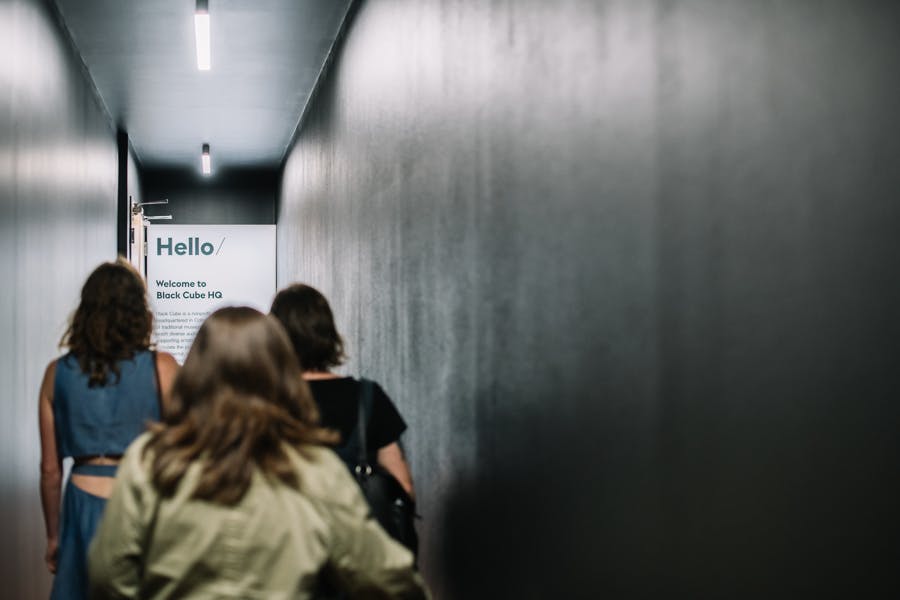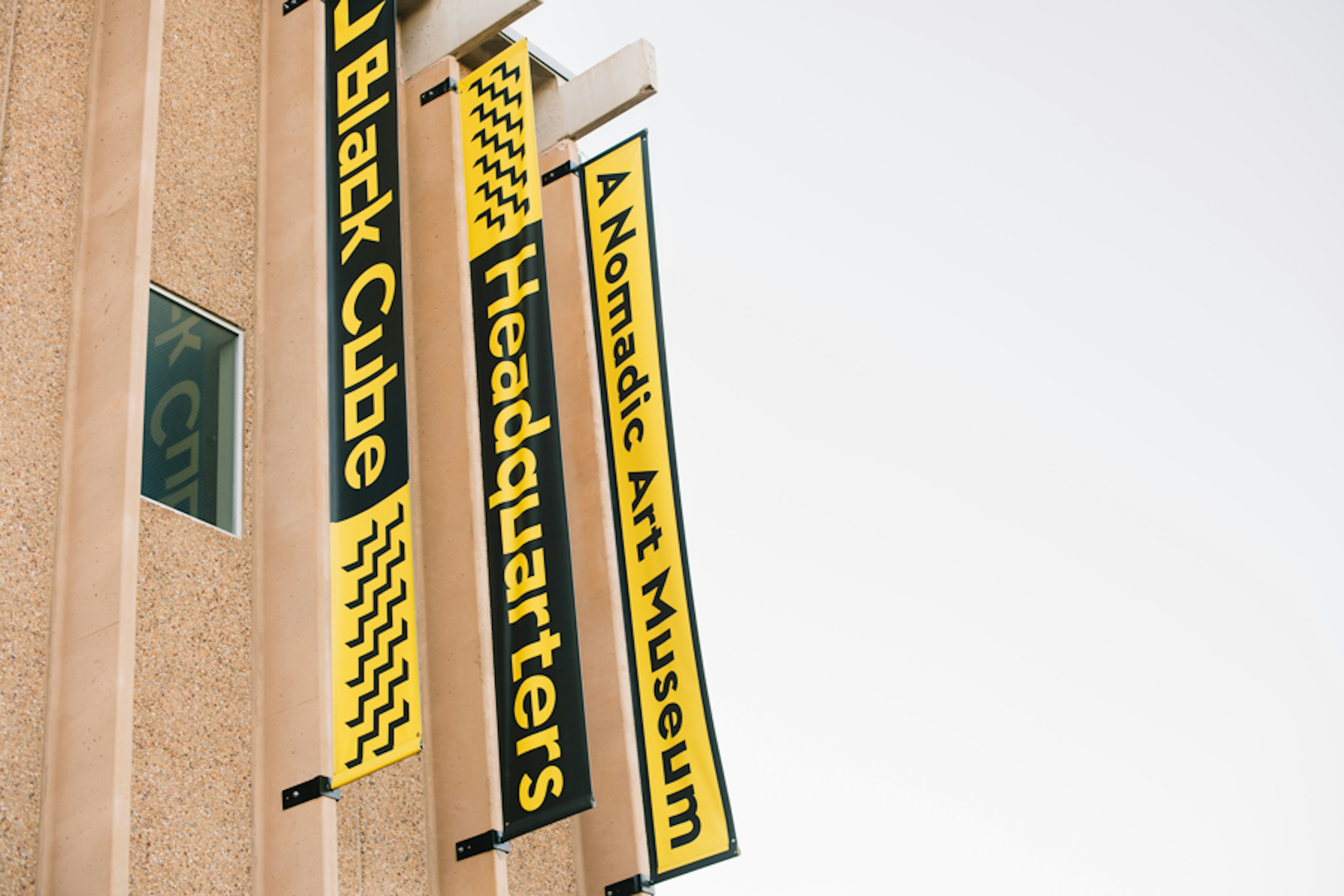Laura Merage on Black Cube’s New Colorado HQ




Cortney Lane Stell, Black Cube’s Executive Director + Chief Curator, interviews Laura Merage, Black Cube’s Founder, about the nomadic art museum’s new HQ in Colorado.
Laura Merage on Black Cube’s New Colorado HQ
Cortney Stell: Laura, it's been a big year for Black Cube with the opening of the headquarters. I’d love to chat with you a little bit about your vision and motivation behind Black Cube’s new growth. But first, what did you envision when you founded our nomadic art museum?
Laura Merage: About 20 years ago, I read a statistic in an article that mentioned the majority of people living in the United States—some percentage like 98%—never walk into an art gallery or museum in their lifetime. I was shocked. From that point on as I encountered art institutions, this statement was something always brewing in the back of my mind. The realization came that as much as museums were working hard to bring numbers through their doors, it continued to be an uphill battle. It begged the question, why not take art out to people? Why not have our daily lives have components of art in it? No matter if we are consciously aware of it or not. So, the idea stemmed from that. Let’s take art into the public, so the public can enjoy art on an everyday basis.
CS: Black Cube has existed nomadically for three years. But, in 2017, you began looking for a building for the organization. Were you thinking the building would be a headquarters at that point? Can you speak about how the headquarters came to be?
LM: Of course. At that point, I wasn’t necessarily envisioning a headquarters for the organization. In my head, I was simply searching for a place for artists and people to gather. I felt Black Cube’s nomadic nature could be enhanced by having a space where the public, including artists, could congregate, as well as a building for the museum to host lectures, events, exhibitions, and more.
CS: So, would you say the headquarters was an addition to how the organization was already functioning? Or, was the intention for the organization to change?
LM: No, the addition of the headquarters was not for the organization to change. The vision was for the building to go hand-in-hand with how the organization was operating as a nomadic museum. In addition, to add programming that we could not have produced nomadically.
CS: It seems like the building signifies a deeper commitment to the Denver metro region. Would you say that’s accurate?
LM: Correct. It’s a very deep commitment. Black Cube is committed to this region and by establishing a headquarters, we are solidifying this notion.
CS: I’d like to talk about the physical aspects of the building. Can you describe your process in searching for a building? What was it that you were looking for?
LM: Yes. I was looking for a warehouse-type building because I wanted a space that had potential for flexibility. I wanted the building to have high ceilings and an openness, so it could lend itself well to gatherings and exhibitions. This narrowed my search very quickly.
CS: So, you didn’t want to establish a headquarters in areas like the Golden Triangle or RiNo?
LM: No. Because the type of building I was looking for doesn’t exist in those areas. I would have had to build it and I didn’t want to start that kind of a project. It wouldn’t make sense for Black Cube.
CS: What attributes did you hope the building would convey?
LM: Flexibility and comfortability. Again, I was searching for a space where I envisioned the public and artists coming together to feel inspired, supported by one another, and a part of a community.
CS: Well, you ended up finding a really unique warehouse building. Can you describe what stood out to you about the building?
LM: You know, I wasn’t initially looking for a two-story building, which this building is. But then, I thought it would be interesting to use each level for something different. As you know, we ended up leasing the first floor. The second floor seemed more fitting for Black Cube Headquarters. It has an open kitchen, which we’ve utilized for gatherings and meals with the community. Next to the kitchen is a large, open, flexible space for exhibitions, or whatever it needs to be for the organization. The high ceilings and open floor plan allow for large-scale art installations. The space also has the ability to be transformed in order to host intimate conversations or presentations. In all, it fits the bill very well.
CS: What did you find intriguing about the location?
LM: The building is located in the Light Industrial District. Because of this, people are usually surprised when they arrive at Black Cube Headquarters. This gives me joy, actually—to bring people to a part of Denver that they’ve never experienced because they had no reason to go there prior. It’s kind of like going on an adventure. But, beyond that, it’s also rewarding to bring art to a part of Denver that likely doesn’t encounter contemporary art very often. This, of course, is Black Cube’s mission and what the organization has set out to do.
CS: The entrance into the building is quite curious and is the only change to the original floorplan. Can you speak about what the experience is like when entering Black Cube Headquarters?
LM: It initially felt awkward, even jarring, when you opened the door directly into such a vast and open space. The solution was to create a long, dark hallway that you enter into first. It’s somewhat disorienting, but I see it as an opportunity to transition from the outside world and sensory overload of daily life.
CS: Speaking of art, we opened the headquarters in mid-September with an experimental group exhibition titled The Fulfillment Center. Can you speak about the conversations we’ve had about pushing the envelope with exhibition-making and how art is displayed?
LM: This organization is about looking at every angle for opportunity. We had so many conversations about how to utilize this building, which is so different from other art spaces. I feel in the beginning we had a tendency to look at the challenges. My task became turning perceived challenges into opportunities. I thought we should embrace the warehouse-nature of the building and the surrounding area and transform the building into a “warehouse exhibition space.” So, instead of having portable walls built to display artwork, we installed and assembled pallet racking shelves. This display encouraged The Fulfillment Center concept.
CS: What makes how the artwork is displayed in The Fulfilment Center unique?
LM: The exhibition is set in a very unique way. The viewer’s experience in seeing artwork that is installed on warehouse shelves is very different. Further, the exhibition structure impacted how the artists created their artwork. It encouraged the artists to think deeply about the whole notion of Fulfillment Centers in United States, and globally. What does it mean for our culture? What does it mean for my art? Should it impact my art? Should we embrace it? All of these questions that the artists began to ask themselves showed beautifully in the work they presented for the exhibition. I feel the artists’ deep research into the theme and opportunity to engage such a different display was so successful in connecting with the viewer.
CS: In discussing the ‘behind-the-scenes’ aspects of the exhibition that really make Black Cube’s approach to working with artists unique and different, is the fact that we commission new, ambitious artworks that somehow challenge artists or help them grow. Is that something that you take pride in with this exhibition and the organization as a whole?
LM: I would have to say it is the aspect that I am most proud of. To support artists in this novel way is a source of pride for me. I feel such gratification when I meet with the artists we work with and see their happiness in being able to practice in a more sustainable way.
CS: How do you envision Black Cube Headquarters fitting into the wider cultural landscape of Denver? How do you think it compares with other organizations here, and how does it stand apart?
LM: I think it’s a piece of the puzzle that was missing from the art community here in Denver and in Colorado. I see how wonderfully Black Cube has formed partnerships with other institutions and organizations in the region. This aspect has been integral towards enhancing the visual arts in our state. I feel that the headquarters is a resource for a stronger art community and enhances our ability to accomplish that much more.
